Barber of Seville 101
When it comes to opera, it is hard to find a more recognizable score than The Barber of Seville. From the iconic overture, to the finale, Rossini’s masterpiece is one of the most widely performed operas in the world (and for good reason!). Even if you’ve never studied music, I can guarantee that you can hum a few tunes. Just think of Bugs Bunny in The Rabbit of Seville… That iconic episode happens to be the most-frequently mentioned memory when we ask folks about their first exposures to opera. Pop-culture has absolutely adored The Barber of Seville… Rossini’s rapid-fire patter, expansive orchestrations, and undeniable bel canto melodies all made for excellent cartoon fodder. Everyone from The Little Rascals, to Sesame Street, to The Simpsons have tapped into Figaro’s quintessential “Largo al factotum” or, as it is better known, “That Figaro, Figaro, Figaro, song.”
Take a deep dive into The Barber of Seville and see if you can leave this page not humming a tune or two! Below, in our first official Opera 101 Series, I’ll present all the Who, What, Where, When and Why’s of each mainstage Opera Colorado production, highlighting the characters, a basic synopsis, and most importantly, a huge playlist of Barber of Seville pop-culture moments! But I won’t be alone. Music Historian Betsy Schwarm, who has been the expertise behind Opera Colorado’s pre-performance lectures for decades, is here to add an additional layer of context and insight. Starting us off, Schwarm notes, “Last spring, Figaro got married on the Opera Colorado stage to the accompaniment of Mozart’s music. This fall, in what one might call the prequel, Rossini introduces us to the character in his opera The Barber of Seville.”
The goal with this new blog series is to arm you with some additional and exciting info, whether you’re an opera aficionado or total newbie, that will increase your understanding of the specific show and enrich your opera experience (even if you never make it to the Ellie Caulkins Opera House). Keep your eyes peeled for more exciting Opera 101 content on our blog!
Can you think of another pop-culture reference? Comment below and let us know what your favorite Barber of Seville moment is. We’ll add it to the playlist too!
BARBER’S ORIGIN TALE
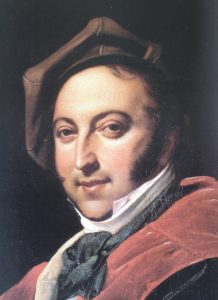
Anyone who still has nightmares about fast-approaching deadlines will relate to Rossini writing Barber under intense pressure and a rapidly approaching deadline. According to legend, the 24-year-old Rossini wrote the score in less than 12 days. As anyone who has had to crank out a paper at the very last minute can empathize, Rossini ended up recycling the overture from another opera he had written previously. Talk about a shortcut!
According to Schwarm, “When Rossini’s Barber of Seville premiered February 20, 1816, the composer was not quite 24 years old, but already had written 16 operas. Many had premiered to the highest acclaim. So Rossini’s jealous elder rivals attempted to ruin his premiere with boos, hisses, and releasing a cat on the stage. Imagine how unsettling all of that would have been to the performers, who continued undaunted, much to the delight of the general audience. By the opera’s second night, it was already a hit.”
THE BARBER OF SEVILLE IN POP CULTURE

That Figaro Tune: If you recognize anything from The Barber of Seville, it will definitely be Figaro’s entrance aria. When asked about what the most iconic part of the opera is, Schwarm exclaims, “FIGARO, FIGARO, FI-GA-RO!” It’s almost the first music we hear from the title character – other than a few off-stage “la-la-lah’s.”In the aria, actually titled “Largo al factotum,” Figaro bounds onto the stage and introduces himself to the audience as clever, competent, and outgoing – exactly the sort of man you need on your side when trouble is afoot. Of course, some of that trouble he may have initiated himself, but the man certainly had charisma, a fact the music makes abundantly clear.”
In one of the best references to “Largo al factotum,” is when Robin Williams (yes, THAT Robin Williams) is recording a voice over in the opening scene in Mrs. Doubtfire. “The brilliant comedian tackles only the last third of the aria, and his pitch control is a bit uncertain, but the rapid fire rhythms – and even the Italian text – are spot on. Williams’ performance brings to mind the thought that perhaps Figaro’s aria was the original “patter song.” A patter song is a term usually associated with Gilbert and Sullivan, but when a great many words are sung really, really fast: that’s a patter song. Many a Figaro performer might go on to tackle the role of the Major General in Pirates of Penzance later in their career.”
The “Largo al factotum” playlist:
More Than An Overture: Despite being written for another opera and then being plopped into Barber, the opera’s overture has become an undeniably iconic component of the show. The orchestral enterprise has been used in cartoons, commercials, and in countless covers and instrumentations. The rapid patter and bouncing melody makes for a total ear worm.
The Barber of Seville Overture Playlist:
Singing Barbers: Although Stephen Sondheim was inspired by the Victorian penny dreadful serial The String of Pearls, Sweeney Todd owes a tip of the hat (or razor) to The Barber of Seville. “What elicits laughter in Rossini’s Barber of Seville becomes much darker in Sweeney Todd, frequently to unnerving effect precisely because Sweeney Todd inverts comic conventions familiar from such works as Barber.” There are more parallels between the two works, including the pursuit of off-limits love, overbearing guardians with shady motives, unscrupulous henchmen, and on-stage shaves. There is also the undeniable caricature of the Italian Barber, who struts his way through remarkable vocal lines with swagger and a wink. Schwarm notes, “When it comes to barbers in musical theater and opera, there are two basic types: The dreaded “Demon Barber of Fleet Street” and the other who sings out the exuberant “Figaro – Figaro – Fiiiiii-ga-AH-ah-ro!”
The Italian Barber, Pirelli:
“Every kind of music is good, except the boring kind.” Gioacchino Rossini
THE CHARACTERS
- COUNT ALMAVIVA – A young nobleman (tenor)
- FIGARO – A barber (baritone)
- ROSINA – A wealthy young lady and Dr. Bartolo’s ward (mezzo-soprano)
- DOCTOR BARTOLO – Rosina’s guardian (bass)
- DON BASILIO – A music teacher (bass)
Want to know more about the singers who will be appearing in Opera Colorado’s production? Check out this page for headshots and bios.
THE SETTING
18th Century Seville, Spain
THE PLOT
Act I
Scene 1
Outside Doctor Bartolo’s house in Seville, Count Almaviva serenades Rosina. Figaro, a local barber, enters and tells Almaviva that his beloved Rosina is actually Doctor Bartolo’s ward. Almaviva tells Figaro that he is seducing her in the guise of “Lindoro,” a poor student, because he wants to make sure she loves him for who he is and not his aristocratic title. The two conspire to outsmart Bartolo by billeting (housing) Almaviva, disguised as an inebriated soldier, in the house.
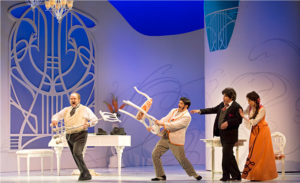
Scene 2
Rosina is determined to marry “Lindoro,” but Don Basilio, her music teacher, warns Bartolo that he himself wishes to marry her and he fears that his marital prospects are in danger. Bartolo has a marriage contract drawn up, but Figaro overhears their plot. Figaro warns Rosina and promises to courier a message from her to “Lindoro.” Bartolo suspiciously confronts Rosina as Almaviva enters in his drunken-soldier getup, declaring his status as a billeted soldier in the house. He passes Rosina a note and soldiers enter to arrest him. Instead of arresting him, they salute their comrade-in-arms, as he sneaks them a bag of gold.
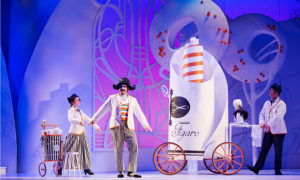
Act II
Scene 1
Bartolo rid his house of the drunken soldier, but he opens his doors to another camouflaged Almaviva. This time he is disguised as “Don Alonso,” a supposed substitute music tutor for the “ill” Basilio. “Don Alonso” gains Bartolo’s trust as he produces Rosina’s letter to Almaviva, later offering to persuade Rosina that the letter has come to him by a mistress of Almaviva. Bartolo nods off during Rosina’s lesson and Almaviva and Rosina, recognize each other immediately and share their mutual adoration. Figaro arrives to shave Bartolo, armed with the keys to the balcony. Basilio suddenly arrives, almost thwarting their newly-hatched plan to escape via the balcony, but he gets told he looks ill and is sent away with a bag of gold. Bartolo, no longer oblivious, uncovers the elopement plan and chases Almaviva and Figaro away. Basilio returns, admitting that he has never heard of this “Don Alonso.” Instructed by Bartolo, Basilio departs to fetch a notary for the expedited wedding. Bartolo uses Almaviva’s letter, stolen earlier, to convince Rosina of Almaviva’s intention to seduce and betray her. Rosina retreats to her room after agreeing to marry Bartolo. Bartolo rushes off to fetch the police.
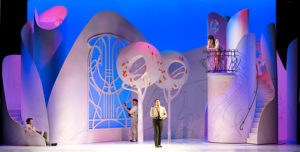
Scene 2
Figaro and Almaviva arrive during a storm and Almaviva reveals his true-identity to Rosina. Their rejoicing is suddenly cut short when Basilio enters with the notary. Figaro insists that the notary wed Rosina and Almaviva instead, as Almaviva bribes Basilio into acting as a witness. Bartolo arrives too late to stop the union and instead blesses the marriage.
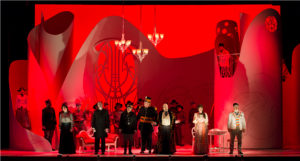
Kelly Maxwell is Opera Colorado’s Multimedia Producer.
Opera Colorado’s production of Rossini’s The Barber of Seville opens Saturday, November 2. Tickets and more information can be found here.



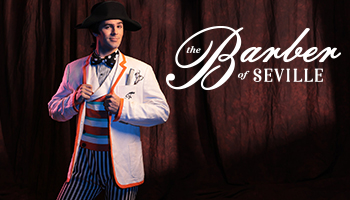
2 Comments to “Barber of Seville 101”